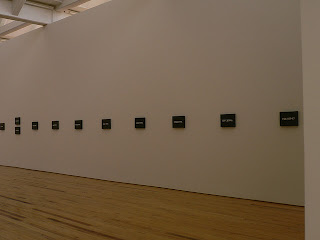Dear Tom and Alistair,
The following are some thoughts that have been rattling
and tapping under the bonnet as I've been trundling along
THE SINGLE ROAD with you.
Familiar as I am with many of the artists you mention and
much as I have enjoyed their work over the years, I have
often found myself somewhat puzzled whilst reading your
blog. I couldn't agree more that the emphasis placed upon
such notions as 'development' and 'progress' fail to encompass
the practices of a significant portion of profoundly interesting
work made in recent decades. Indeed I'm much more comfortable
thinking of art as something that changes or perhaps even
evolves but this is where the puzzlement begins because
if some artists choose to constrain or limit the evolution
of their work - to stop changing it - then where does this
leave them/us and what insights are likely to be gained by
doing so ?
Although by no means a universal truth, there does seem to be
a common experience encountered by many artists in their early
career where they happen upon a discovery or shift in perspective
that transforms their outlook on life and the work they make.
Such transformations are often characterised by the development
of a new 'vision' that reveals previously unforeseen possibilities.
I remember during a talk at Inverleith House Carl Andre spoke
of how this happened for him via an unintendedly insightful
comment made by Frank Stella about one of Andre's works that
threw him into an utterly new conception of the potential of sculpture.
Since that time Andre has explored innumerable ways to reform
this single foundational insight and the differences, whilst often
relatively subtle, are at once inventive, playful and reiterative of
this profound realisation, that sculpture is not an addition but rather
a subtraction from space.
Genuine discoveries would appear to be as rare in art practice as
in any other area of human dealing so perhaps it is only natural
that artists should wish to plumb their discoveries as fully as possible
- whether it takes just a day or a whole lifetime. This might also
explain why artists are often disinclined to start afresh amongst
unfamiliar territory where failure and disappointment is necessarily
far more common than discovery.
However, I realise that art need not always be a quest in search of
discovery. Some artists might choose to repeat an aspect of the
tradition in a devotional act not dissimilar to that described in the
astonishing scene in Tarkovski's "Sacrifice" that you mentioned
recently. Similarly they might be gripped by 'Functionslust': a
German term that describes the pleasure of doing something for its
own sake as opposed to the pleasure of producing an effect or
generating an object of value. The emphasis being entirely focussed
on the process rather than the product - the journey along the road
as opposed to the destination. However, whilst I can very much
appreciate how some artists might be drawn into a deep relationship
with certain practices and processes, I'm less convinced (or perhaps
'less certain' would be a better way to put it) about the potential for
insight offered by the products of their activity. And here we come
back to the issue of insight which, as it turns out, is little different from
discovery really.
But if we dispense with development, progress, discovery and now
insight what are we actually left with ?
Best
Jim
Dear Jim,
It's not our purpose in The Single Road to defend, let alone
recommend, the artists involved. They represent a significant
aspect of practice which is less known than it used to be, and
less understood. We really set up the blog to draw attention to
this way of working and to try to understand it ourselves, in part
from the kind of perplexity you mention.
Your point about art making as pushing through to 'a discovery
or shift in perspective' is one that is dear to me too. Unless some
new insight is to be had from art, why would anyone look at it ?
Without a sense of adventure and discovery, why would anyone
make it ?
But I wonder if we are right to insist too dogmatically on discovery
and insight. Perhaps there are other interests and pleasures to be
had. I do find that I am glad to hear, from time to time, that On
Kawara is still alive. It seems a beautiful thing now, that Opalka
continued his life's project right to the end. No doubt I would be
mildly distressed, if Alan Charlton started to make blue paintings.
Consistency may be one critique of change, commitment of a wider
lack of commitment. Daniel Buren's single strategy seemed to work
as a critical intervention into institutions and expectations, at least for
a time. Reinhardt's black paintings remain as hermetically sealed as
they were 50 years ago, in some ways more so. Here the discoveries
are to be made around the art, as it were, rather than within it.
There is a story that Wittgenstein didn't mind what he had for dinner
- as long as it was the same every day ! This is unusual, but many
people enjoy the same breakfast every morning, wearing the same
clothes, coming home to the same person. Why should such
continuities and recognitions be excluded from art ?
In fact, the everyday and its improvement has become a strong theme
in recent art. Concern is less with the exceptional circumstance
(insight and discovery) than with the ordinary, the customary.
That is where anyone lives, most of the time. Opalka and the others
have a relevance here as artists who have chosen a set of
parameters, an everyday circumstance, a working life.
With best wishes,
Tom










































